If you want to know about the brick masonry or types of bonds in brick masonry or about underpinning, please click the link.
Scaffolding refers to the temporary structures, typically made of metal pipes and wooden planks, used to support workers and materials during construction or maintenance work on buildings or other structures.
Scaffolding is essential for ensuring worker safety and providing a stable working platform at heights. It typically needs to meet safety regulations and be erected by trained professionals.
- A temporary elevated platform and its supporting Structure used for supporting workmen, materials, or both in the construction or repair of buildings and other large structure.
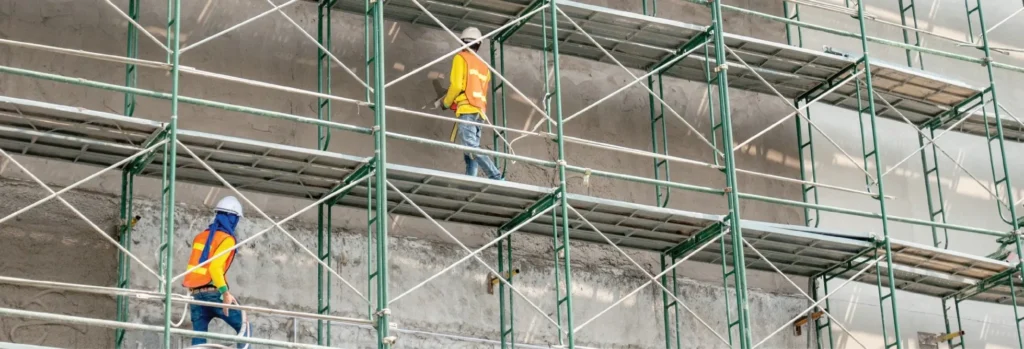
- Scaffolding is generally needed when the height of the structural member (wall, column, etc.) is greater than 1.5m.
- The scaffolding should be made by sufficient strong and stable materials so that it can easily support and carry workman and construction materials placed on it.
- During construction, as the work progress on upwards, the height of the scaffolding is also increased.
1) Scaffolding Process
- Scaffolding process is defined as the planning for, the design of, the Erection of, the inspection of, the use of, and the dismantling of any scaffolding. The scaffolding process does not include the erection of structures constructed using scaffolding components, such as falsework, temporary grandstands, lighting towers, etc
2) Design Requirements
- Principles of Design
- The strength, stability and rigidity of the supporting structure.
- The handling normally associated with scaffolding.
- The safety of persons engaged in the erection, alteration and dismantling of the scaffold.
- The safety of persons using the scaffold.
- The safety of persons in the vicinity of the scaffold.
- Basics of Design (Includes IS codes for designing of scaffolds)
- Load Combinations
- Design Loads
- Dead Loads
- Environmental Loads
- Live Loads
- Supporting Structure
- General (Structure should be capable of supporting the most adverse combination of loads applied by the scaffolds.)
- Strengthening of supporting structure
- Soleplates
3) Component parts of scaffolding

- Standards: These are the vertical members of the framework, supported on the ground or drums, or embedded into the ground.
- Ledgers: The horizontal supporting members running parallel to the wall.
- Braces: Braces are diagonally fixed on standards.
- Putlogs: Putlogs are placed one end on ledgers and other ends right angles on the wall. This is a transverse member.
- Transoms: Transoms are a type of putlogs supported on ledgers on both sides.
- Bridle: This is a member used to bridge a wall opening; supports one end of the putlog at the opening.
- Boarding: Boarding is a horizontal platform supported on putlogs and is used for the support of workmen and materials at the time working.
- Guard rail: This is a rail, provided like a ledger, at the working level.
- Toe board: These are boards, placed parallel to ledgers, and supported on putlogs, to give protection at the level of the working platform.
4) Standing Scaffolds
- This part covers standing scaffolds which are supported wholly or partly from their base. The scaffolds may be either free-standing or held sideways by ties, rakers or other means.
The kinds of scaffolds generally used are
- Timber scaffolding.
- Tube scaffolding in steel or aluminum.
i) Timber Scaffoldings
- Radiata pine and Douglas fir are suitable timbers for use in the scaffolding.
- All timber used in scaffolding should be preservative treated in accordance with an appropriate commodity specification of the Timber Preservation Authority.
- Standards for timber scaffoldings:
- Putlogs
- Bracing
- Guardrail and midrail
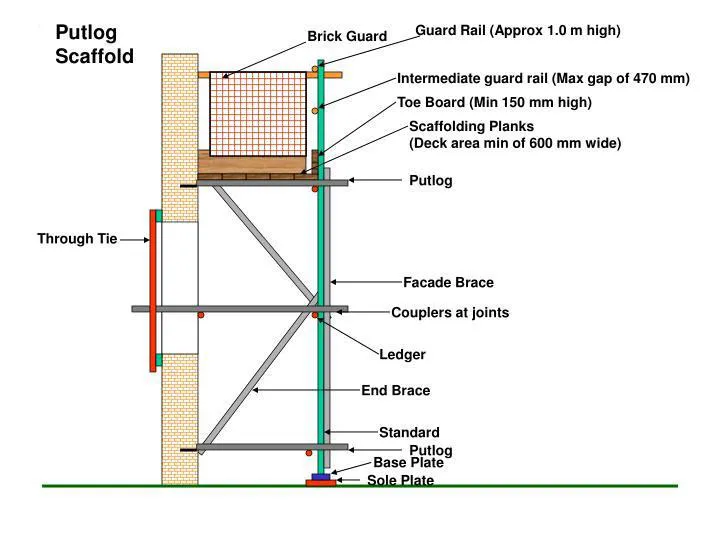
ii) Tube Scaffolding in Steel or Aluminum
- Metal tubes must be purpose made with outside diameters accurately gauged to fit properly into the metal couplings and to allow complete Interchangeability.
- Tubes in use on a scaffold must be in good condition, free from bends and defects that might affect strength, reasonably free from corrosion and cut square at the ends.
- Tubes which are 3 m and over in length should be reamed, if cut, to ensure safety when using internal joiners.
- When the loss of metal by corrosion or other causes reduces any cross section of a tube so that its corresponding weight is less than 90 percent of its original weight, the affected length of tube is to be discarded and rendered unfit for further use in scaffolding.
- Steel tubes must be hot-dipped galvanized or painted when used in scaffolds which are exposed for prolonged periods to marine or corrosive atmospheres.
- Fittings and couplings must be specially made for the tubes in use and must be of a satisfactory quality as to strength and performance.
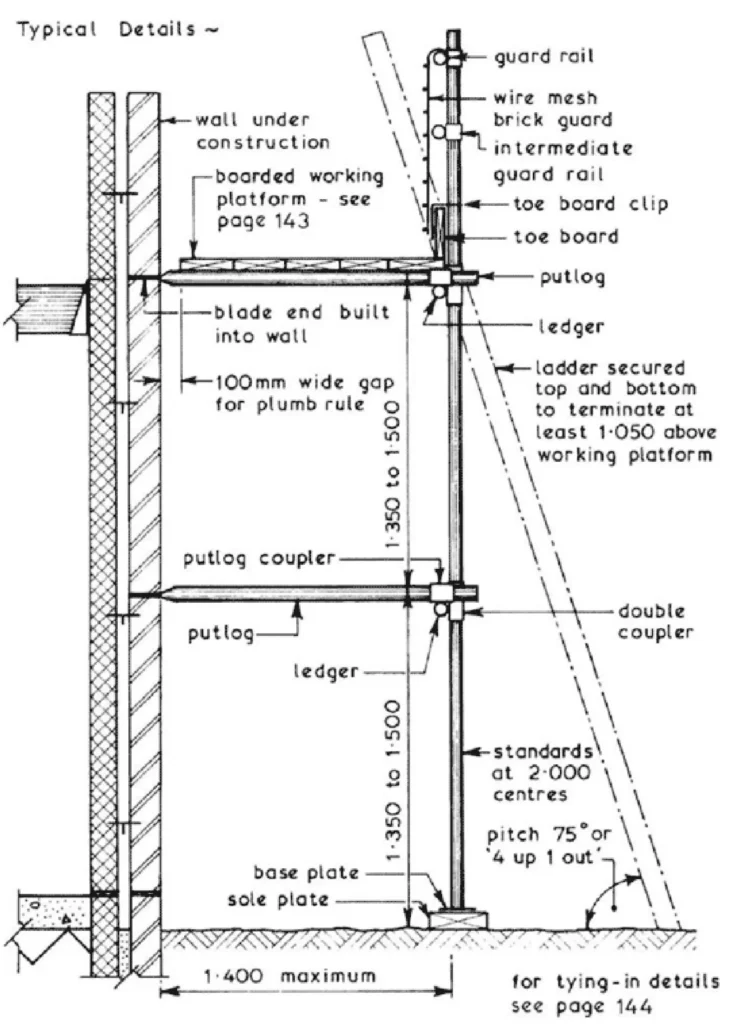
- Fittings must be carefully maintained in good order and condition.
- They must not be left lying around but stored in bags, boxes or bins, and kept well-oiled and protected from rusting.
- Special attention must be given to the care and checking of screw threads and nuts; worn or distorted parts must be discarded or replaced. Cracks or other flaws must be watched for.
Materials
- Steel Tubes
- Aluminium Tubes
- Ccouplers and Accessories
Specific Requirements for Standing Scaffolds
- Standards
- Ledgers
- Putlogs
- Ties
- Braces
8) Types of Scaffoldings
- Single scaffoldings
- Double scaffoldings
- Cantilever scaffoldings
- Suspended scaffoldings
- Trestle scaffoldings
- Steel scaffoldings
- Patented scaffoldings
i) Single Scaffoldings
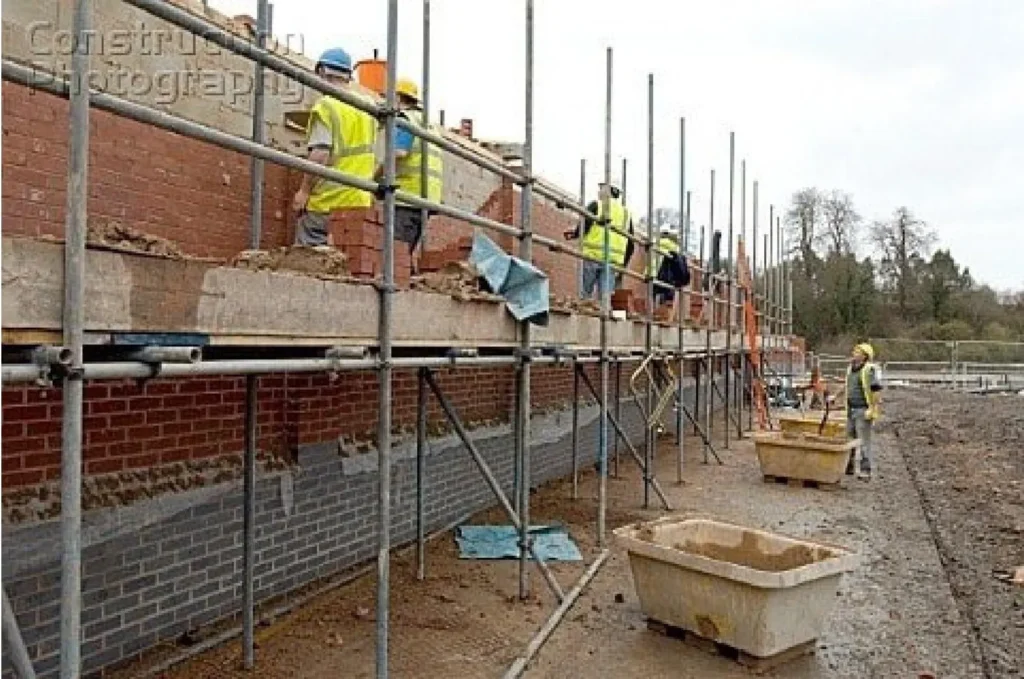
- Single scaffolding is generally used for brick masonry,
- Also called as brick layer’s scaffolding. Single scaffolding consists of standards, ledgers, putlogs etc., which is parallel to the wall at a distance of about 1.2 m.
- Distance between the standards is about 2 to 2.5 m. Ledgers connect the standards at vertical interval of 1.2 to 1.5 m.
- Putlogs are taken out from the hole left in the wall to one end of the ledgers. Putlogs are placed at an interval of 1.2 to 1.5 m.
ii) Double Scaffoldings

- Double Scaffolding is generally used for stone masonry so, it is also called as mason’s scaffolding.
- In stone walls, it is hard to make holes in the wall to support putlogs. So, two rows of scaffolding are constructed to make it strong.
- The first row is 20 – 30 cm away from the wall and the other one is 1m away from the first row.
- Then putlogs are placed which are supported by the both frames.
- To make it more, strong rakers and cross braces are provided. This is also called as independent scaffoldings.
iii) Cantilever Scaffolding
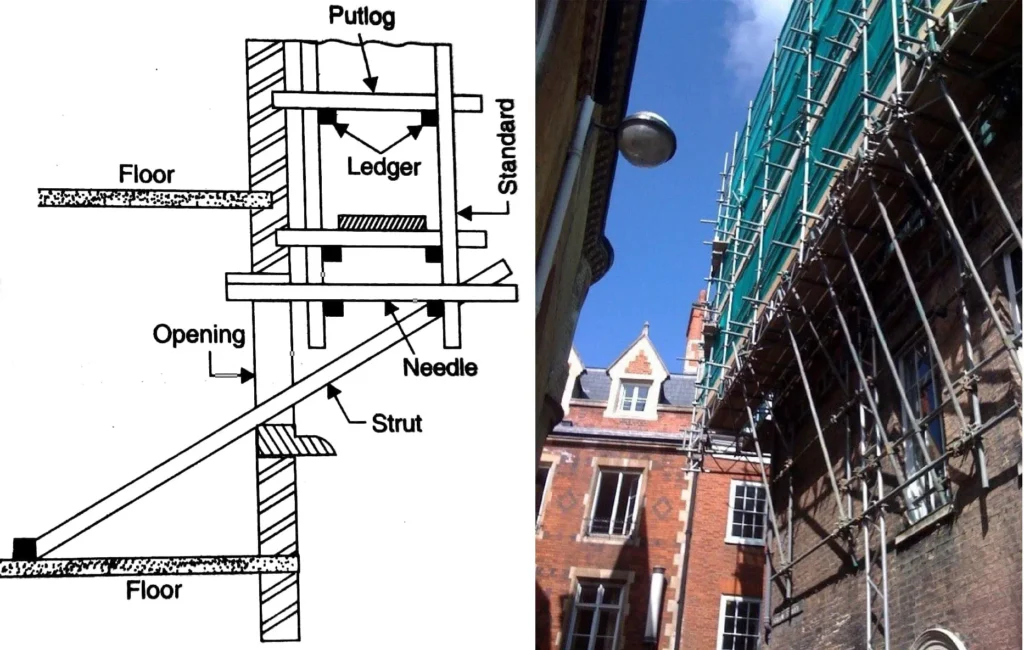
- This a type of scaffolding in which the standards are supported on series of needles and these needles are taken out through holes in the wall. This is called single frame type scaffolding. In the other type needles are strutted inside the floors through the openings and this is called independent or double frame type scaffolding. Care should be taken while construction of cantilever scaffolding.
- Generally cantilever scaffoldings are used under conditions such as :
- When the ground does not having the capacity to support standards,
- When the Ground near the wall is to be free from traffic, When upper part of the wall is under construction.
iv) Suspended Scaffoldings
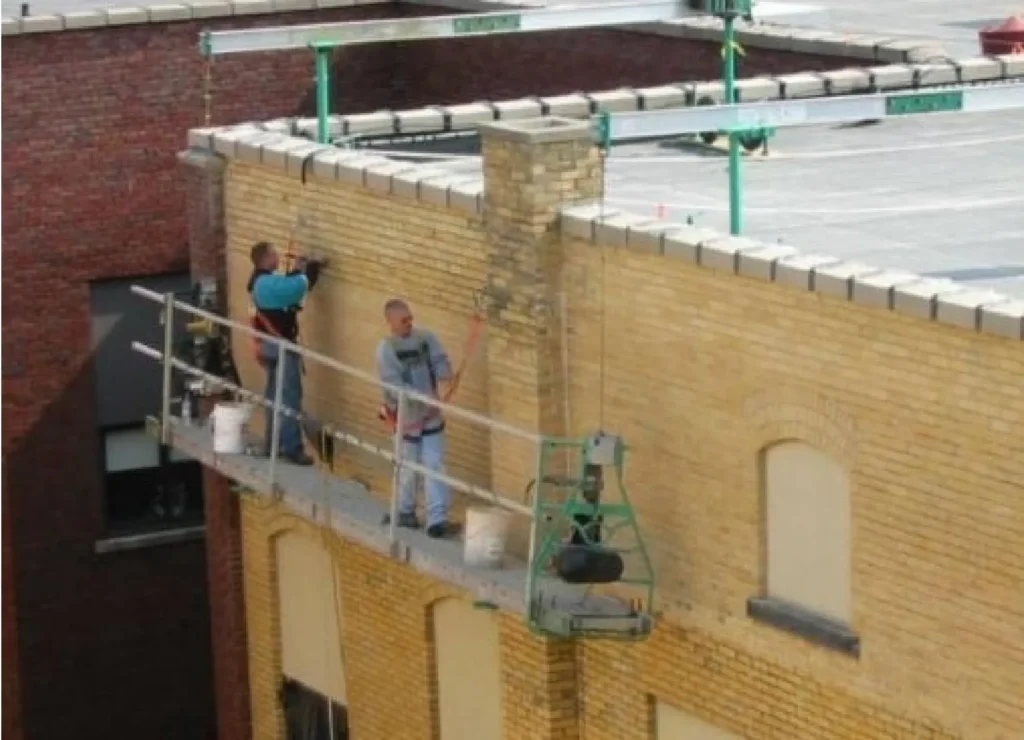
- In suspended scaffolding, the working platform is suspended from roofs with the help of wire ropes or chains etc., it can be raised or lowered to our required level.
- This type of scaffolding is used for repair works, pointing, paintings etc.
v) Trestle Scaffoldings
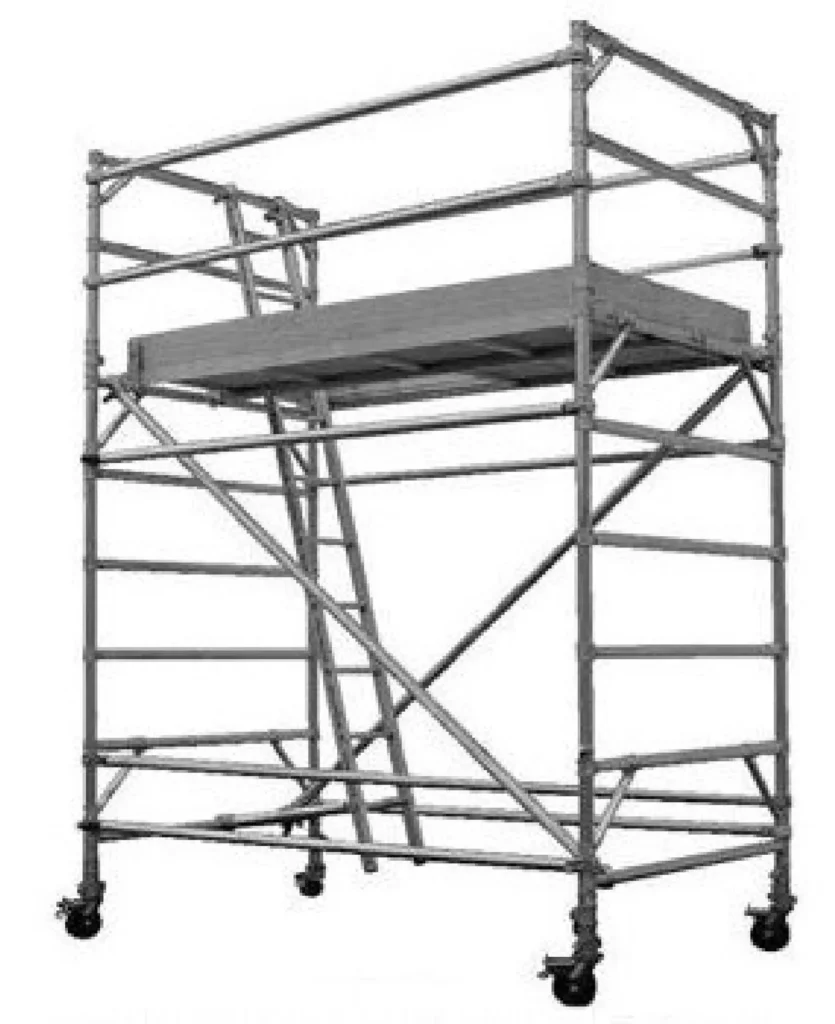
- In Trestle scaffolding, the working platform is supported on movable tripods or ladders.
- This is generally used for work inside the room, such as paintings, repairs etc., up to a height of 5m.
vi) Steel Scaffoldings
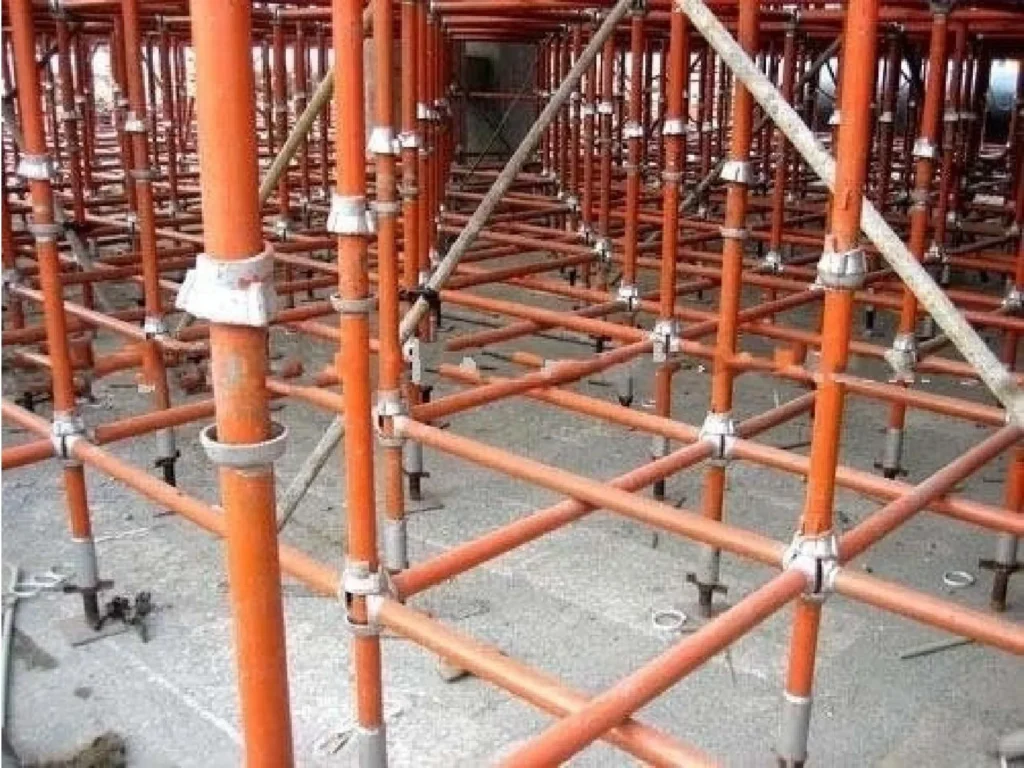
- Steel scaffolding is constructed by steel tubes which are fixed together by steel couplers or fittings.
- It is very easy to construct or dismantle.
- It has greater strength, greater durability and higher fire resistance.
- It is not economical but will give more safety for workers.
- Used extensively nowadays.
vii) Patented Scaffolding
- Patented scaffoldings are made up of steel, but these are equipped with special couplings and frames etc., these are readymade scaffoldings which are available in the market. In this type of scaffolding working platform is arranged on brackets which can be adjustable to our required level.
9) Strutting and Waling
- Strut is a structural component designed to resist longitudinal compression. Struts provide outwards-facing support in their lengthwise direction, which can be used to keep two other components separate, performing the opposite Function of a tie.They are commonly used in architecture and Engineering.
- Waling is an upright structure of masonry, wood, plaster, or other building material serving to enclose, divide, or protect an area, especially a vertical construction forming an inner partition or exterior siding of a building.
Scaffolding can also pose safety risks if it is not properly erected or maintained. It is important to follow safety regulations and guidelines when using scaffolding and to train workers on proper usage and safety measures. Additionally, regular inspections and maintenance of scaffolding is necessary to ensure it remains safe and stable for use.